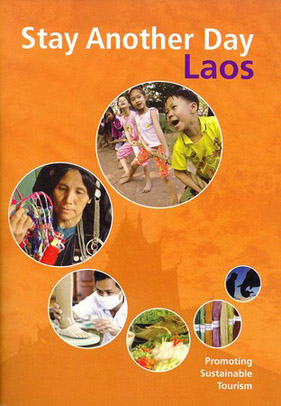Laos throws doors open to eco tourists

At the heart of the revolution is Stay Another Day, an initiative that produces a fabulous offering of the country’s sustainable organizations.
In a hilltribe settlement in the forest of northern Laos, an old man sits on the ground weaving a basket while another villager hangs out her washing to dry.
It is a scene of everyday life for the Akha communities living in the Nam Ha Protected Area, where elephants, gibbons and leopards roam among giant bamboo near villages perched on the banks of a tributary of the Mekong river.
The 220,000-hectare national park is at the forefront of efforts by the landlocked, impoverished nation to become a leading eco-tourism destination – an effort that appears to be paying off.
Lured by the wild beauty and cultural riches of the numerous ethnic minorities, almost 250,000 tourists visited northwest Luang Namtha province in 2010, up from 20,000 in 1999, according to the Laos tourism administration.
After opening up to foreign visitors in the 1990s, Laos "quickly saw that being a country in the middle of the Mekong region, with many visitors going to the surrounding countries, that it would be a good opportunity to develop the economy and create local jobs," said Steven Schipani, who was involved in the Nam Ha ecotourism project as a UN advisor.
"But they were also aware that tourism, if not properly managed, can cause a lot of negative impacts," added the American, who is now in charge of the Asian Development Bank’s Southeast Asia tourism programme.
The Laotian authorities, who have created 20 national parks covering 14 percent of the country, attempted to manage the explosion in tourism so as to avoid queues of coaches or rows of concrete hotels.
"Laos will become a world renowned destination specialising in forms of sustainable tourism that, through partnership and cooperation, benefits natural and cultural heritage conservation and local socio-economic development, and spreads knowledge of Laos’ unique cultural heritage around the world," says the state run website www.ecotourismlaos.com.
The Nam Ha national park, thanks to a partnership with UNESCO dating back to 1999, has served as a model of development for ecotourism aimed at benefitting local communities.
Thanks to the Nam Ha project, several dozen villages have signed agreements with local trekking agencies to supply guides, maintain the paths, share their traditional cuisine and offer a roof for the night, no more than twice a week.
Hundreds of similar projects are being set up elsewhere in the sparsely populated country, one of the poorest in the world.
Tourist arrivals in the Communist nation have risen from scarcely 5,000 in 1991 to more than two million in 2009, according to official figures.
After decades of isolation, Laos has opened up its arms, however slightly, to the international arena. It is a crossroads state between Thailand and Vietnam and a close partner with neighboring China
There are green initiatives all across the nation from the northern mountains of Luang Namtha to the 4,000 islands in the south. Many organizations have offices in Vientiane and Paske, though Luang Prabang remains the heart and soul of the movement.
Source: AFP
Valere Tjolle
Valere Tjolle is editor of the Sustainable Tourism Report Suite – special offers HERE
 United Kingdom
United Kingdom United States
United States Asia Pacific
Asia Pacific












































Dozens fall ill in P&O Cruises ship outbreak
Turkish Airlines flight in emergency landing after pilot dies
Boy falls to death on cruise ship
Unexpected wave rocks cruise ship
Storm Lilian travel chaos as bank holiday flights cancelled